- Publisher’s Note
- Editorial
- Progressive Artists Group of Bombay: An Overview
- S. H. Raza: The Modern
- Ara: The Uncommon Commoner
- Art of Francis Newton Souza:A Study in Psycho-Analytical Approach
- M.F. Husain: An Iconoclastic Icon
- Husain’s ‘Zameen’
- Life and Art of Sadanand Bakre
- Hari Ambadas Gade: Relocating the Silent Alleys
- Mysticism Yearning for the Absolute
- Modernist Art from India at Rubin Museum of Art, New York
- Traditional Art from India at the Peabody Essex Museum
- Nandan Mela 2011: A Fair with Flair
- India's First Online Auction of Antiquities
- The Market Masters
- Markets May Plunge and the Rich May Flock To Art
- What Happened and What's Forthcoming
- Random Strokes
- Julian Beever: Morphing Reality With Chalk Asthetics
- Eyes on Life: Reviewing Satish Gujral’s Recent Drawings
- Exploring Intimacy: Postcards of Nandalal Bose
- Irony as Form
- Strange Paradise
- Eyeball Massage: Pipilotti Rist
- René Lalique: A Genius of French Decorative Art
- The Milwaukee Art Museum – Poetry in Motion
- 9 Bäumleingasse
- Art Events Kolkata: November – December 2011
- Art Bengaluru
- Mumbai Art Sighting
- Delhi Dais
- Tacita Dean at Turbine Hall, Tate Modern, London
- Preview: January, 2012 – February, 2012
- In the News: December 2011
ART news & views
Progressive Artists Group of Bombay: An Overview
Issue No: 24 Month: 1 Year: 2012
The Spirit of Late 1940s and Early 1950s
by Ratan Parimoo and Nalini Bhagwat

It was during the 1990s as India was celebrating the 50 years of independence that many of us realized the significance of the artist groups formed during late 1940s and early 1950s. I call it the ‘spirit’ of the era in the life of our culture, which struck many creative minds and spread in many parts of the county. This undoubtedly cries to be recognized as a most significant turning point in the development of modern Indian Art. It was consciously the starting point of a new introspection art the Bengal School “Revival Movement,” and the naturalistic art practice taught in the art schools. The Independence in 1947 was a “moment” of continued nationalist fervor combined with a fresh nation-wide excitement and optimism, inspite of the heavy suffering due to the partition of the subcontinent.
I see myself as a spectator-participant of the contemporary art phenomenon of the last 60 years. I am referring to my experience along with other young art students during the early 1950s at Baroda. We seemed to wish to forget the impact of the end of World War II, the Bengal Famine, the 1942 movement, which was a heightened stridency of the struggle for Independence and equal ruthlessness unleashed by the British colonial administration, and the holocaust of the Hindu-Muslim riots before and after Partition. Often, the Progressive Artists Group set up in Mumbai during the late 1940s has been singled out as a demarcating line but it is significant that even some of the painters of this group developed a greater maturity in their work during the early 50s, like, Gade, Souza, Husain, Raza, Ara and Bakre (the latter in sculpture).
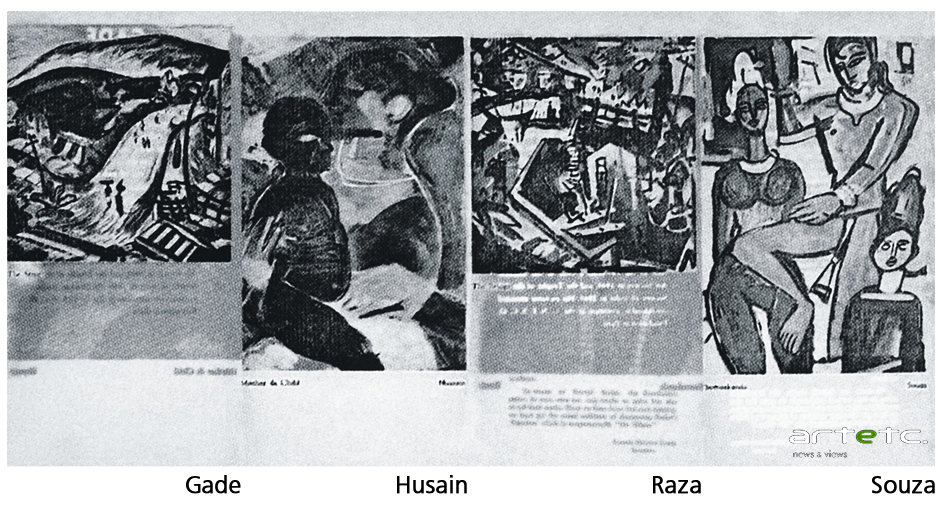
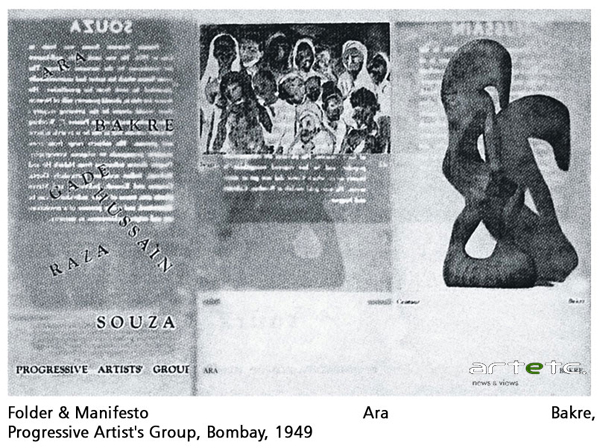 Today, we can look at the situation with an eye on parallel manifestations. Calcutta during the late 40s had witnessed artists like Somnath Hore and Chitta Prasad amongst others, who responded to the Bengal Famine, while those who gathered courage to move away from the Bengal School formed the Calcutta Group, were Nirode Mazumdar, Paritosh Sen, Sunil Madhav Sen, Gopal Ghose, Prodosh Das Gupta, Shubha Tagore, Rathin Mitra and Gobardhan Ash, who grew into serious artists as they worked through the 50s. Indeed, it can be claimed that the formation of the Calcutta Group and the exhibition of Jamini Roy’s work in Mumbai during the late 1940s (with a record of press reviews) were among the sources of inspiration to artists in western India.
Today, we can look at the situation with an eye on parallel manifestations. Calcutta during the late 40s had witnessed artists like Somnath Hore and Chitta Prasad amongst others, who responded to the Bengal Famine, while those who gathered courage to move away from the Bengal School formed the Calcutta Group, were Nirode Mazumdar, Paritosh Sen, Sunil Madhav Sen, Gopal Ghose, Prodosh Das Gupta, Shubha Tagore, Rathin Mitra and Gobardhan Ash, who grew into serious artists as they worked through the 50s. Indeed, it can be claimed that the formation of the Calcutta Group and the exhibition of Jamini Roy’s work in Mumbai during the late 1940s (with a record of press reviews) were among the sources of inspiration to artists in western India.
With the setting up of the Shilpi Chakra Group during the year 1947 by refugee artists arriving from Lahore, besides other migrating artists including Sailoz Mukherjee, B.C. Sanyal, Dhanraj Bhagat, Dinkar Kowshik, K.S. Kulkarni followed by Satish Gujral’s return from Mexico, the dormant situation suddenly picked up dynamism in Delhi. To mention further developments in Western India, several contemporary artists like N.S. Bendre, K.K. Hebber, Baburao Sadwelkar, V.S. Gaitonde and S.B. Palsikar, were associated with what was called the Bombay Group. Two younger artists, Akbar Padamsee and Tyeb Mehta had affiliated themselves to the Progressive Artists Group while Jehangir Sabavala also charted the course of his career at that time. It is interesting to note that with Bendre, Sankho Chaudhuri and then young K. G. Subramanyan moving to Baroda by 1950-51, an active scene began emerging there due to what I have called the winds of change blowing from Mumbai. Thus, the Baroda Group of artists could be formed in 1956 with youngsters such as Shanti Dave, Jyoti Bhatt, Triloke Kaul, G.R. Santosh, Balkrishna, Ratan Parimoo, Praful Dave and subsequently, Gulam Sheikh, Himmat Shah, V.R. Patel and others. Activities in Madras are recorded with D. P. Roy Chaudhury’s sculptures and the rise of K.C.S. Panikkar and Dhanapal as teachers of painting and sculpture respectively. During the 50s, they organized the Progressive Painters’ Association culminating in the formation of the Chola Mandal, as a South Indian answer to modern art movement in the rest of the country.
The “spirit” or the Zeitgeist of a time or era in the life of a culture that I have been talking about is a Hegelian concept. (We may also call it the “moment” vide John Berger’s paper, The Moment of Cubism, listing various developments in European civilization during the first decade of the 20th century). The circumstances at the beginning of the post-Independence period of India considering the tremendous fervor and optimism in so many spheres, political, social, economic and cultural forms (literature, theatre, film, dance, music, architecture) appropriately justify bringing in this notion here. I am aware of the criticism and variations over this concept, for example the economic determinism, or the role of flesh and blood individuals instead of some metaphysical force.
Although the first exhibition of the Progressive Artists Group was held in 1949, in the then Bombay city, the group came formally into existence as early as 1947, in a meeting held on December 15, (which was reported in ‘Blitz’ dated Dec. 20 of that year). The arbitrary selection at the current exhibitions of the Bombay Art Society had prompted some artists and critics to organize such a meeting. The persons who spoke at this historical conclave included the artists Souza, Raza and Ara besides the critic Rashid Hussain. Expressing their utter disappointment with the judging and the lack of principle on which the exhibits were accepted for display, they insisted that the Judging Committee should be an elected body who should be able to justify before the public their choice of exhibits based on specific art values. The artists were especially perturbed over the rejection of same remarkable paintings like Ara’s ‘Independence Day Procession’. Rashid Hussain criticized the old orthodox critics and declared the necessity of the artists taking initiative in developing a conscious art patronage among the masses with deliberate social purpose in their art. Newton (Souza initially referred to himself by this name) exhorted that artists should get together to thrash out common problems and initiate the development of a new national art. Ara demanded that artists should have freedom, ‘svatantrata’ for their expression and should overthrow the living corpse of the worshippers of false art. Before this meeting, four of the artists had already met and decided to exhibit their works together. These were Ara, Raza, Souza and Bakre. Two more were added soon. Hussain was persuaded by Souza while Gade was brought into the fold of the PAG by Raza. Bakre who had been convinced by Ara, was already in the Group. They decided to limit the number of members at six in order to avoid stylistic scramble. The title ‘Progressive’ was inspired from the Progressive writers’ movement which was started in Indian literature by the Marxist novelists, poets and fellow travelers at a conference held in 1936. The PAG had an anti-Imperialist outlook and the objective of ‘bridging the widening gulf between the artists and the life of the people’ was declared in the short manifesto.
 Oldest member of the PAG, K. H. Ara, was born in 1914 at Hyderabad who was bought to Bombay by his grandfather at the age of seven. He began his life from a humble beginning, having worked at different types of jobs he was employed for washing of cars by a local Japanese firm. Painting in his leisure hours he started exhibiting in art exhibitions and surprisingly won prizes also. Walter Langhammer, the then art director of the Times of India and Rudi Van Leyden, the art critic, noticed his talent and encouraged him. It has been acknowledged that, Ara blossomed into a painter under their guidance. Ara won the ‘Times of India prize’, in 1939. In 1941 he won a prize for the second time for his ‘Flora Fountain’. Leyden saw a quality of genius in his careless dashes of paint and rather crude drawing, insisting that Ara take a few elementary lessons in Art. In his first one-man show of 1942, Ara revealed a dynamic spontaneity in his water colour paintings which were mostly still-lives, wine glasses, grapes, pine apples and earthen pots. His colour schemes and dynamic force were noted which are qualities associated with naïve or folk artists. Ara came into lime light when he won the Governor’s prize at the Bombay Art Society’s exhibition.
Oldest member of the PAG, K. H. Ara, was born in 1914 at Hyderabad who was bought to Bombay by his grandfather at the age of seven. He began his life from a humble beginning, having worked at different types of jobs he was employed for washing of cars by a local Japanese firm. Painting in his leisure hours he started exhibiting in art exhibitions and surprisingly won prizes also. Walter Langhammer, the then art director of the Times of India and Rudi Van Leyden, the art critic, noticed his talent and encouraged him. It has been acknowledged that, Ara blossomed into a painter under their guidance. Ara won the ‘Times of India prize’, in 1939. In 1941 he won a prize for the second time for his ‘Flora Fountain’. Leyden saw a quality of genius in his careless dashes of paint and rather crude drawing, insisting that Ara take a few elementary lessons in Art. In his first one-man show of 1942, Ara revealed a dynamic spontaneity in his water colour paintings which were mostly still-lives, wine glasses, grapes, pine apples and earthen pots. His colour schemes and dynamic force were noted which are qualities associated with naïve or folk artists. Ara came into lime light when he won the Governor’s prize at the Bombay Art Society’s exhibition.
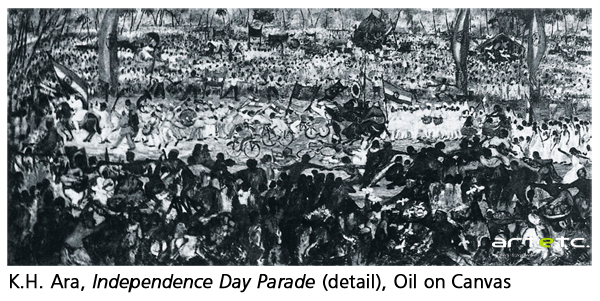
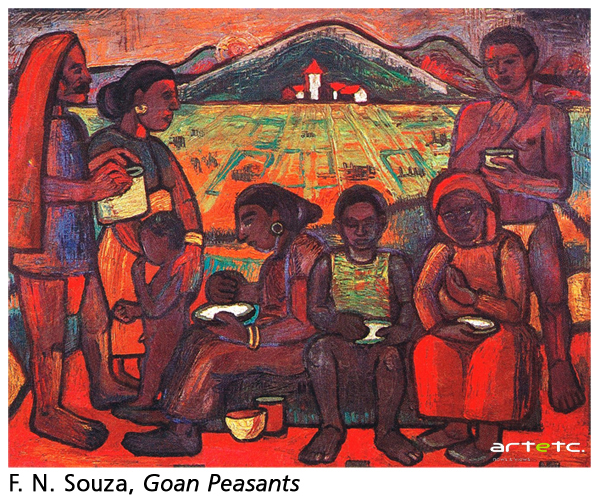
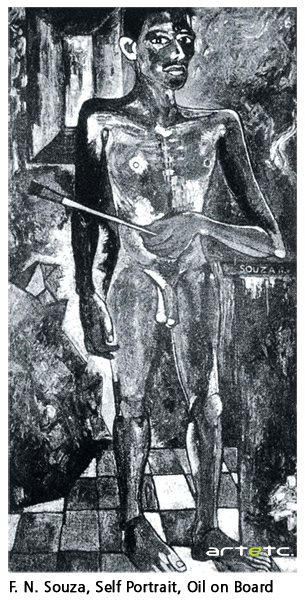 As far as Francis Newton Souza is concerned, from hind sight, it can be claimed that all the while some kind of inner struggle was going on in his mind as a youth. Born in 1924 in Goa in a Roman Catholic family, he lost his father when he was barely three months old. Soon after, his little sister also expired. Later, when Souza came to know about these tragedies, he bore a ‘curious feeling of an ancient guilt’ as if like the Greek mythological king, namely Oedipus, he had inadvertently killed his father. Little Souza was brought to Mumbai by his widowed mother, where she took a job as a dressmaker. In his high school days he had been found guilty of scribbling pornographic drawings on the walls of the school lavatories. He joined Sir J. J. School of Art in 1940, where the comprehensive teaching programme aimed at giving the young artists a sound basis of naturalistic skills and craftsmanship which included study from nude models, portraiture and landscape painting. Souza mastered these genres and proved his talent by winning prizes in the Art School exhibitions. An episode in the final year involving expression of overt patriotism became the reason for his expulsion from the Art School. Souza briefly joined the Communist party and in this period he portrayed Marxist philosophy related ideals in some of his paintings titled ‘Goan Peasants’, ‘Bombay Proretariat’ etc. however, he soon left the Communist Party for some unknown reasons. Earlier writers on Souza have built up his image as someone who was full of bitterness, the cause of which was his personal sufferings. It was natural for him to develop into an iconoclast who wanted to destroy everything that was considered good and moral according to the so-called high-brow society. He was intelligent enough to be able to give his intensions a broad ideological orientation. He succeeded in motivating likeminded artists to form a group to engage in some shocking activities that would attract the attention of the art world. A good writer with a powerful language he became the spokesman of the PAG. He worked out a manifesto in which he also expressed his own ideas stating that ‘they wanted to take art away from the sophisticated arty-arty crowd’. Souza much admired Ara’s caliber as a painter whose work he found “stunning because of its direct, intuitive modernism”. Husain’s talent was also first recognized by Souza persuading him to join the PAG.
As far as Francis Newton Souza is concerned, from hind sight, it can be claimed that all the while some kind of inner struggle was going on in his mind as a youth. Born in 1924 in Goa in a Roman Catholic family, he lost his father when he was barely three months old. Soon after, his little sister also expired. Later, when Souza came to know about these tragedies, he bore a ‘curious feeling of an ancient guilt’ as if like the Greek mythological king, namely Oedipus, he had inadvertently killed his father. Little Souza was brought to Mumbai by his widowed mother, where she took a job as a dressmaker. In his high school days he had been found guilty of scribbling pornographic drawings on the walls of the school lavatories. He joined Sir J. J. School of Art in 1940, where the comprehensive teaching programme aimed at giving the young artists a sound basis of naturalistic skills and craftsmanship which included study from nude models, portraiture and landscape painting. Souza mastered these genres and proved his talent by winning prizes in the Art School exhibitions. An episode in the final year involving expression of overt patriotism became the reason for his expulsion from the Art School. Souza briefly joined the Communist party and in this period he portrayed Marxist philosophy related ideals in some of his paintings titled ‘Goan Peasants’, ‘Bombay Proretariat’ etc. however, he soon left the Communist Party for some unknown reasons. Earlier writers on Souza have built up his image as someone who was full of bitterness, the cause of which was his personal sufferings. It was natural for him to develop into an iconoclast who wanted to destroy everything that was considered good and moral according to the so-called high-brow society. He was intelligent enough to be able to give his intensions a broad ideological orientation. He succeeded in motivating likeminded artists to form a group to engage in some shocking activities that would attract the attention of the art world. A good writer with a powerful language he became the spokesman of the PAG. He worked out a manifesto in which he also expressed his own ideas stating that ‘they wanted to take art away from the sophisticated arty-arty crowd’. Souza much admired Ara’s caliber as a painter whose work he found “stunning because of its direct, intuitive modernism”. Husain’s talent was also first recognized by Souza persuading him to join the PAG.
 Although reluctant to participate in any controvercies, yet Husain too had experienced poverty and difficulties as a youngster and yielded to Souza’s persuation. Maqbul Fida Husain was born in 1915 at Pandharpur (Maharashtra) in the Sulaimani Bohra community. After his birth his father moved to Indore where he passed his childhood. Husain’s mother died when he was 3 years old followed by the death of his paternal grandmother who was looking after him. Subsequently he was sent to his maternal grandfather at Siddhpur in Gujarat where the latter was head of a religious sect. Here Husain learnt to read Urdu and was much attracted towards the geometric forms of Kufic Calligraphy. Later he was shifted to Baroda where he joined a Madrasa under the guidance of his uncle who wrote religious poetry. Husain cultivated to write poetry assuming the pen-name ‘Haya’. As an adolescent he had to return to Indore to join his father. Unfortunately instead of completing school education he was apprenticed to a tailor but significantly side by side Husain developed the hobby of painting. Winning a gold medal at an annual show at the age of 17, prompted him to join the Art School at Indore. After 3 years he arrived in Mumbai to study at the Sir J. J. School of Art. However it was only since 1937, when he decided to fully devote himself to painting, living in a cheap room in the slum area near Grant Road undertaking all kinds of odd jobs. He painted cinema posters, designed nursery furniture, embellishing cots and rocking horses in colorful designs. The oil painting ‘Sunehra Sansar’ brought him to limelight in 1946 when it was awarded a prize at the Annual exhibition of Bombay Art Society for its remarkable composition. When in 1948 Souza saw Husain’s painting ‘Potters’ at the Bombay Art Society’s exhibition he decided to bring Husain into the fold of the PAG.
Although reluctant to participate in any controvercies, yet Husain too had experienced poverty and difficulties as a youngster and yielded to Souza’s persuation. Maqbul Fida Husain was born in 1915 at Pandharpur (Maharashtra) in the Sulaimani Bohra community. After his birth his father moved to Indore where he passed his childhood. Husain’s mother died when he was 3 years old followed by the death of his paternal grandmother who was looking after him. Subsequently he was sent to his maternal grandfather at Siddhpur in Gujarat where the latter was head of a religious sect. Here Husain learnt to read Urdu and was much attracted towards the geometric forms of Kufic Calligraphy. Later he was shifted to Baroda where he joined a Madrasa under the guidance of his uncle who wrote religious poetry. Husain cultivated to write poetry assuming the pen-name ‘Haya’. As an adolescent he had to return to Indore to join his father. Unfortunately instead of completing school education he was apprenticed to a tailor but significantly side by side Husain developed the hobby of painting. Winning a gold medal at an annual show at the age of 17, prompted him to join the Art School at Indore. After 3 years he arrived in Mumbai to study at the Sir J. J. School of Art. However it was only since 1937, when he decided to fully devote himself to painting, living in a cheap room in the slum area near Grant Road undertaking all kinds of odd jobs. He painted cinema posters, designed nursery furniture, embellishing cots and rocking horses in colorful designs. The oil painting ‘Sunehra Sansar’ brought him to limelight in 1946 when it was awarded a prize at the Annual exhibition of Bombay Art Society for its remarkable composition. When in 1948 Souza saw Husain’s painting ‘Potters’ at the Bombay Art Society’s exhibition he decided to bring Husain into the fold of the PAG.
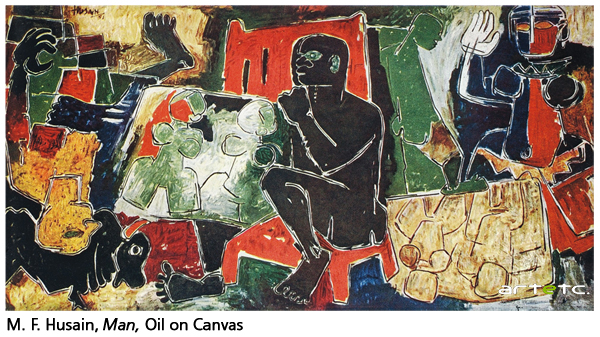
Temperamentally Raza was much different than Souza if we consider the fact that the former was happy appreciating nature’s beauty and expressing his own pleasure through his paintings. Said Hyder Raza was born at Bawaria in Madhya Pradesh in the year 1922. He received initial art training at Napgur School of Art. His Nasik landscapes earned the scholarship offered by Art Society of India for a tour of India for the purpose of landscape paintings. He exhibited a group of water color landscapes depicting Bombay Street scenes at the Bombay Art Society’s Annual exhibition in the year 1944. He combined the element of opaque color popularized by Bendre and Solegaonkar, (known as Indore School) along with the broad execution and the panoramic bird’s eye-view observed in Langhammer’s landscapes, usually the oils. Raza’s water color landscapes at the 1944 exhibition were admired by critics as ‘juicer’ and ‘delightful’, and he was pronounced to be trying to out-Bendre Bendre. In 1946 his landscapes displayed at the Bombay Art Society’s annual exhibition won the silver medal and were specially commented by the critic, Rudy Van Leyden, such as ‘Bori Bundar’ and ‘The Dasasvamedh Ghat’. He was hailed as the surest and most sensitive painter of landscapes in the whole exhibition. His main intention to discard the old naturalistic style and evolve his own to suit his expression, may be the main reason for agreeing to join the grievances of his fellow artists of the PAG.


Born in 1917 at Berar, H. A. Gade was the only person from the PAG who had a sound university background. He earned degrees in Science and Education from Nagpur University. He received preliminary art training at Nagpur completing his diploma from the Sir J. J. School of Art at Mumbai. His paintings were noticed from 1946 onwards for good understanding of emotional qualities of color and a certain kinship with Raza’s landscapes. Such comments had been made for the two of his paintings ‘Narrow Lane’ and ‘Fountain Jubbalpore’ displayed in the 1947 exhibition of Bombay Art Society. Gade also experimented in various directions which may be the reason Raza insisted that he join the PAG. In his early figurative works he was influenced by Shergil-sque elements and elementary simplification of forms in child art.
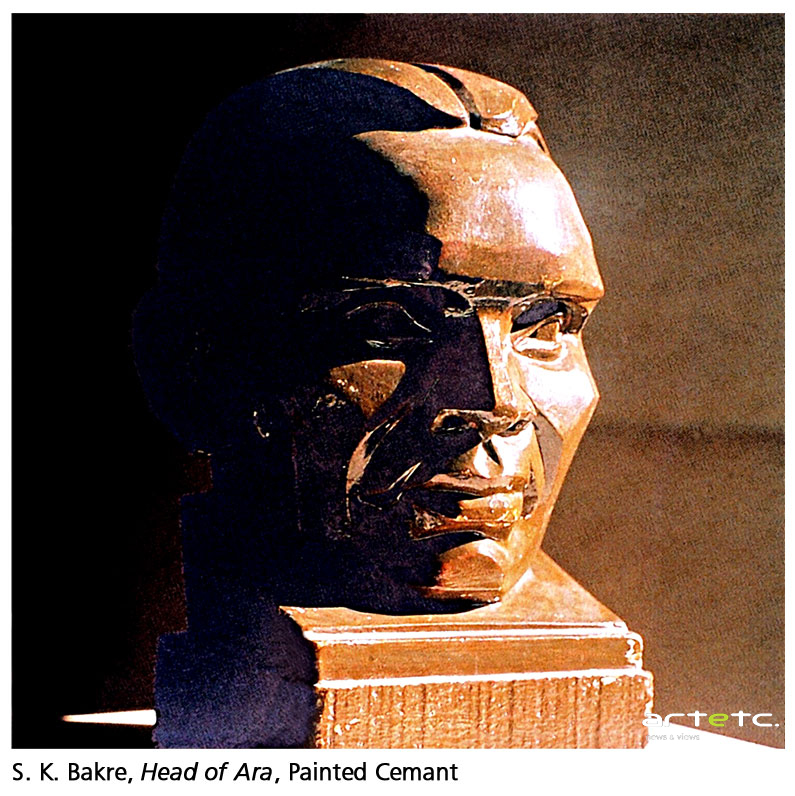 The only sculptor member of PAG, Sadanand Bakre was born at Baroda in 1920. He joined the J. J. School of art, Bombay, where he was known as a very bright student, winning the Mayo Gold Medal reserved for the best student. He developed a special flair in the genre of portraiture. As early as 1940 his portrait bust ‘My Father’ was exhibited in the annual exhibition of Bombay art Society of that year. His portrait titled ‘Seer’ won a prize in the exhibition of 1942. His exhibit in the next year, was a bust given the title ‘My Deeper Self’ was much more interesting and expressive. His sculptures were characterized by sensitive modeling and distinct expression. Replacing naturalistic techniques he adopted the modeling technique of the British sculptor, Jacob Epstein, and experimented with cubist planes as in his portrait of Ara. He was interested in the art of painting also having won a prize for ‘Sketch from Ambarnath’ in 1942. Bakre too had developed some kind of resentment against the so-called highbrows and orthodox art critics. Due to this reason and his friendship with Ara he was motivated to join the PAG as its founder member.
The only sculptor member of PAG, Sadanand Bakre was born at Baroda in 1920. He joined the J. J. School of art, Bombay, where he was known as a very bright student, winning the Mayo Gold Medal reserved for the best student. He developed a special flair in the genre of portraiture. As early as 1940 his portrait bust ‘My Father’ was exhibited in the annual exhibition of Bombay art Society of that year. His portrait titled ‘Seer’ won a prize in the exhibition of 1942. His exhibit in the next year, was a bust given the title ‘My Deeper Self’ was much more interesting and expressive. His sculptures were characterized by sensitive modeling and distinct expression. Replacing naturalistic techniques he adopted the modeling technique of the British sculptor, Jacob Epstein, and experimented with cubist planes as in his portrait of Ara. He was interested in the art of painting also having won a prize for ‘Sketch from Ambarnath’ in 1942. Bakre too had developed some kind of resentment against the so-called highbrows and orthodox art critics. Due to this reason and his friendship with Ara he was motivated to join the PAG as its founder member.
The first group exhibition of the PAG held at Bombay Art Society’s Salon at Rampart Row in 1949, was a spectacular success, in terms of the bold and innovative works and also in terms of the excitement that it aroused among art connoisseurs. As noted earlier the six founder members Ara, Souza, Raza, Husain, Gade, Bakre participated in this exhibition which was opened by the celebrated author-critic, Mulk Raj Anand, known for his novels with leftist leanings. He commended the six ‘Progressives’ as the ‘heralds of a new dawn in the world of Indian art’. In their catalogue they had used Samuel Butler’s quotation as their motto, viz, ‘young art must be working out its own salvation from efforts in all fear and trembling”. Rudi Van Leyden’s consistent exhibition reviews in Bombay during the 1940s gave the air of expectation of something important to happen from the young artists. His review of the PAG exhibition is both expositive as well as a record of a great historic moment. His review highlights that the six artists formed a ‘distinct group’ inspite of their very different artistic approaches and tempers. He reminded his readers that those who have followed the works of these artists over the past years would know of the struggle, the experiments, the trials that lie behind the considerable achievement which this exhibition represented. In a way the art critic Rudi Van Leyden, the artist Walter Langhammer, the patrons and connoisseurs, Schlesinger and Herman Goetz, the German expatriates, almost served as the tutors of the PAG artists.
Apparently, at the crucial occasion of the PAG exhibition the member artists frankly admitted that the ideology expressed in the manifesto which was set at the time of formation of the Group, ‘was not practicable’. They confessed that ‘we have changed all the chauvinist ideas and the leftist fanaticism which we had incorporated in our manifesto at the inception of the group’ and that ‘the gulf between the people and the artists cannot be bridged’. ‘Today we paint with absolute freedom of contents and techniques that they were now governed by only “sound principles of art” like aesthetic order, plastic coordination and color composition.’
In this overview there is space only to mention Souza’s early phase works which have been documented by the art critic Jagmohan in an exhibition in Delhi (1983). Before the major PAG exhibition (1949) Souza had held his second one-man show which is also called the ‘Farewell Show’. The exhibition was inaugurated by Schlesinger, and it was here that Souza had exhibited his fully naked Self Portrait which had aroused controversy. The show also had examples of works which depicted embracing couples inspired by Khajuraho Sculptures. This is the beginning of Souza’s romance with erotic subject matter. Souza simplified the nudes into tabular limbs painted with heavy lines and making their frontal view conspicuous.
Jag Mohan characterized Souza’s pictorial style as ‘Primitivistic’, since the artist had already rejected the then attempted solutions and sources such as elements from Indian miniatures, the synthesis experimented by artists like Jamini Roy, Amrita Shergil and George Keyt. The latter synthesized Picasso’s cubism and sensuality of Indian sculpture. Souza delineated the peasant groups from the Goa countryside as well as poor families from Bombay slums in a simplified and elemental manner. It may have been the Communist Circles through whom Souza came to know about both earlier as well as current Mexican art evolved by committed Communist artists of that county. This may have been Souza’s first acquaintance with the handling of simplifications and distortions as far as human form is concerned. Souza chose the simplicity and angularity of Spanish Catalan style of Romanesque period for his versions of Christ’s Crucifixion. Souza’s individual show of 1948 and the paintings included in the PAG exhibition of 1949, not only revealed the dramatic flowering of his talent but also his masterly grasp of influences as well as the wide range of his subject matter. He incorporated the coloristic developments made familiar by the practical examples of Langhammar as well as the newly discovered awareness of both German Expressionist use of color as well as Fauvist use of color such as in the French painter, Matisse’s works. In the short note penned for the exhibition folder, Souza was now bold enough to prophesy his personal destiny. “To comprehend and appreciate (modern paintings) one must know one’s way in the world history of art, from Praxiteles to Picasso, from the Han to Manchu dynasty and from Mohenjodaro to Francis Newton”. This may represent the course of his creative journey through London and New York during subsequent decades.
Here it is befitting to mention the interaction between the Calcutta Group of Bengal and the PAG artists. Among many sources of inspiration to the artists in Mumbai had been Jamini Roy’s exhibition helf in 1942 and the Calcutta Group exhibition held in 1945. Though the emergence of PAG took place later than the Calcutta Group, the former’s influence was so dominating that the Calcutta Group painters took initiative in arranging a joint show with them at Kolkata in 1950. Gade himself accompanied with the PAG paintings when they were carried to Kolkata. The critics interpreted the staging of the joint show as a challenge to the conservative art critics and the painters were admired as the precursors of a new movement. Another PAG exhibition outside Mumbai was held at Baroda on the invitation of Dr. Herman Goetz, art-historian and then curator of Baroda State Museum. He bought some of their works including Souza’s ‘Blue Nude’, for the Baroda Museum and Picture Gallery, which was quite encouraging for them. The exhibition also travelled to Ahmedabad.
As the World War II ended in 1945, travelling to Europe and the USA became relatively easier and several Indian artists ventured to travel to Western countries resulting in direct exposure to the new trends in Modern Western art. Souza’s departure for London in 1949, was followed by Bakre, where as Raza preferred to go to Paris. Husain began travelling frequently shuttling between Mumbai and Delhi. Thus the PAG got dispersed. Significantly, the artists remained focused and kept returning to the mother country and exhibiting at intervals in Mumbai and Delhi. So also those, who remained behind like Husain, Ara and Gade. Their periodic exhibitions often received wide publicity in Mumbai and Delhi especially those of Husain, Raza and Souza. However, Souza’s exhibitions were much noticed because of their boldness and his own provocative statements and writings.
The last group show of the PAG was held in 1953. By this time new members had been associated for the purpose of exhibitions, which included, Krishan Khanna (Delhi-based), Gaitonde and Akbar Padamsee. Other names in the last exhibition were Mohan Samant and A. A. Raiba.,
I would like to conclude with a paragraph on Husain from one of my essays of 1975. Husain’s best work can be so overwhelming and sway one off his feet, for sheer simplicity and monumentality of the image, achieved through bold lines, bright resonating color and heavy brush-work. By around 1960, his style arrived at its most characteristic development that one could recognize it easily and “Husainesque” became a catchword. His synthesis of diverse sources starting with folk-like drawing and bright colors which were then handled like the French Fauvists, the Indian line treated like Matisse, allowing the line to predominate while bringing it in right harmony with color, in case of color applied in vertical planes which is a Cubistic principle as well as a feature from Indian miniatures. His figures were, to begin with, linear and mannered according to folk prototypes but they gradually took on the heaviness of the traditional Indian sculpture and even its occasional sensuality. At times, the outline of the figure was broken up into planes which extended into space around it. Similarly color was made to spread beyond the boundaries of the outline to create tension between volume and space, between line and color. Husain’s pictorial devices have been vast and varied and comparison with Picasso in befitting. His pictorial vocabulary is equally matched by the large variety of his themes and imagery. There are, of course, the women, sari-clad and nude, which have local flavor but gradually assume universal characteristics. So also with his Priest series. The woman musician in his Ragamala series is neither a female nor an individual performer but she becomes a visual and chromatic counterpart of music and to my mind these are his best works. The priests and women have a kind of saint-and-courtesan connotation but without implicit sexuality they only serve as contrasts to one another. Similar contrasts are again used in the juxtaposition of woman and horse where erotic suggestions are present. His attitude has been characterized as one where he maintains “creative tension between social involvement and individual freedom”. A number of Husainesque motifs have become so familiar like the large hand delineated in some mudra or the other which peeps out from anywhere on his canvases big or small. Husain in the early ‘sixties seemed to be such a dominant painter on the scene that it appeared that no significant painting of non-Husainesque kind could be possible.
Reference
1. Nalini Bhagwat, Development of Contemporary Art in Western India, Ph. D. Thesis submitted to M.S. University, Baroda in 1983.
2. Yashodhara Dalmia, The Making of Modern Indian Art The Progressives, New Delhi, 2001
3. Ratan Parimoo, Art of Francis Newton Souza, A study in Psychoanalytical Approach, 2003 (unpublished)